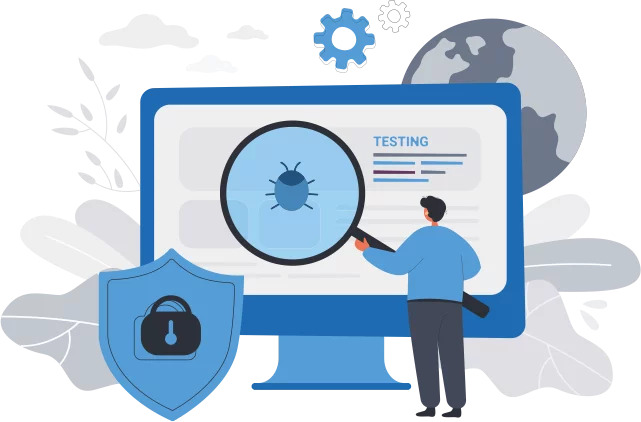To be sure that your business infrastructure is secured from breaches and cyber-attacks and meets, ensure a secured data exchange. Quality and security are paramount for businesses to sustain. To thrive in this digital landscape, you must ensure your business understands the security compliance requirements. Security testing services ensure the quality and security of your business. Safeguard your system from breaches, protect sensitive business data, save time, and be a reliable business among customers.
Ensuring cyber-safety leads to a robust brand image & client retention and better ROI. Equip your system infrastructure and overall business processes, ensuring that all critical information is protected.
How Security Testing Services Streamline Your Workflow

To pave the way for a smoother, faster, and more secure software development journey. Managing security tasks and reducing development hurdles is essential. We have listed the ways security testing can streamline your workflow and let you deliver desirable outcomes.
Automation and Efficiency
- Reduced Manual Testing: Automated testing tools employed by security services significantly reduce the need for manual security testing. It can help developers reduce workload and let QA testers test the software issues, if any.
- Early Detection and Prevention: Vulnerabilities are identified early in the development process, preventing rework, delayed timeline, and delayed software life cycle.
- Integration with CI/CD Pipelines: Security testing can seamlessly integrate into CI/CD pipelines, enabling continuous security throughout the development lifecycle. It also helps to address the bugs in the early stages and streamline workflows
Improved Collaboration and Communication:
- Breaking Down Silos: Security testing services foster a collaborative environment where security professionals and developers work together as a team. This shared knowledge and common goals create a culture of security awareness.
- Automated security testing continuously monitors and gets an overview of issues in the testing system. Accordingly, they can prioritize and apply the security fixes prioritizing and applying the security fixes.
- Clear Communication and Reporting: Detailed reports with actionable insights help everyone understand the results of security testing and prioritize remediation efforts.
Faster Software Development Cycles and Releases:
- Streamlined Workflow: By automating manual tasks and identifying vulnerabilities early, security testing services. This helps eliminate bottlenecks and delays, resulting in software faster development cycles and releases.
- Reduced Risk of Delayed Launches: Proactive security testing service ensures that the release and launches are within the timeline. These measures help to prevent last-minute security issues that could derail launch schedules and impact deadlines.
Enhanced Software Quality and Security:
- Higher Quality Code: Early detection and mitigation of vulnerabilities lead to a higher quality final product with fewer security risks.
- Improved User Experience: Secure software caters to the trust and confidence of users with your software. This leads to a better overall user experience and business presence.
Increased Compliance and Reduced Risks:
- Adherence to Security Regulations: ensure your software adheres to relevant security regulations and standards, minimizing legal risks and penalties.
- Proactive Threat Detection: Continuous security monitoring helps identify and address emerging early stages. Addressing and resolving the issues by giving the best test cases possible.
In essence, security testing is to streamline your workflow by automating tasks, improving collaboration, reducing delays, enhancing software quality, and minimizing risks. They allow you to be more proactive in prevention and security. It ultimately increases development efficiency and builds secure, high-quality software with better performance.
Benefits of Application Security Testing Services

Finding the right balance between secure software and efficient development can be challenging. Application Security testing services come to the rescue, offering a wealth of benefits for businesses of all sizes:
Here are a few benefits of security testing for your software system:
- Improved software security: Reduced risk of vulnerabilities and cyberattacks means protecting your users’ data and brand reputation.
- Faster development cycles: Early detection and mitigation of vulnerabilities. It eliminates delays and rework scenarios and allows the team to focus on innovation.
- Enhanced team productivity: Automated testing tools allow developers to focus on their core strengths, maximizing team efficiency.
- Increased compliance: Adhered to security regulations and standards and met legal and ethical requirements.
- Proactive Approach: Shift from reactive patching to proactive prevention. App Security testing services anticipate and address evolving threats, keeping your software secure and updated.
- Compliance Assurance: Navigate the complex world of security regulations with ease. Ensure your software adheres to industry standards and avoids legal or financial repercussions.
- Brand Protection: A secure software system safeguards your brand image and user trust. Avoid data breaches, maintain customer loyalty, and better user experience.
- Competitive Advantage: Stand out from the crowd with secure software. Attract security-conscious users and gain a decisive edge in the marketplace.
- Improved user experience: Secure software translates to a smooth and reliable experience for your users, boosting satisfaction and engagement.
- Reduced maintenance costs: Proactive security measures prevent future vulnerabilities and security issues. It also saves time and money on costly maintenance and remediation efforts.
- Scalability and flexibility: Customized testing services for your needs and software complexities. Ensuring comprehensive protection regardless of your system’s size or scope
Investing in application testing services is a wise decision that protects your software, brand, and business. It enables you to build secure, reliable, and successful software applications that thrive in today’s digital landscape.
Secure your Software Across the Software Development Lifecycle
Building secure and high-quality software is paramount for business. Security testing practices are incorporated into the software development lifecycle, from the planning stage to execution on the screen.
Here’s how security testing secures your software at every crucial stage:
Stage 1: Planning and Design
- Threat Modeling: Identify potential vulnerabilities and attack vectors early on, shaping a secure architecture from the ground up.
- Secure Design Reviews: Analyze design documents and prototypes for security flaws, preventing costly rework later.
Stage 2: Coding and Development
- Static Code Analysis: Scan code for vulnerabilities and coding errors before any lines are compiled, saving time and resources.
- Software Composition Analysis: Identify and manage security risks within third-party components and libraries.
Stage 3: Testing and QA
- Dynamic Application Security Testing (DAST): Simulate real-world attacks to uncover exploitable vulnerabilities in web applications.
- Penetration Testing: Employ skilled, ethical hackers to probe your software defenses and discover hidden weaknesses.
- API Security Testing: Ensure the security and integrity of your APIs and the vital communication channels between your software and other systems.
- QA testing is vital in security by bringing diverse expertise, efficient automation, and a user-centric approach. Their involvement throughout the SDLC contributes significantly to developing secure, reliable, and trustworthy software products.
Stage 4: Deployment and Maintenance
- Security Configuration Assessments: Verify that your deployed software is configured securely and adheres to best practices.
- Post-Deployment Monitoring: Continuously scan your software for emerging threats and vulnerabilities, staying vigilant even after launch.
By following these steps and integrating security throughout the SDLC, you can significantly improve the security posture of your software. Remember, security is an ongoing process and is essential. Continuously adapt your approach and leverage emerging technologies to secure your system from threats.
Key Takeaways
Investing in application security testing services is not just about mitigating risks; it’s about unlocking your software’s and your business’s full potential. By streamlining workflows, ensuring robust security, and fostering a culture of collaboration, you can:
- Protect your brand and reputation: Data breaches and security vulnerabilities can have devastating consequences. Create a shield safeguarding your business from reputational damage and legal repercussions.
- Gain a competitive edge: Consumers prioritize security, and demonstrably secure software gives you a decisive advantage in a crowded marketplace.
- Unlock innovation: Continuous security throughout the development cycle allows you to innovate confidently, knowing your software is built on a rock-solid security foundation.
